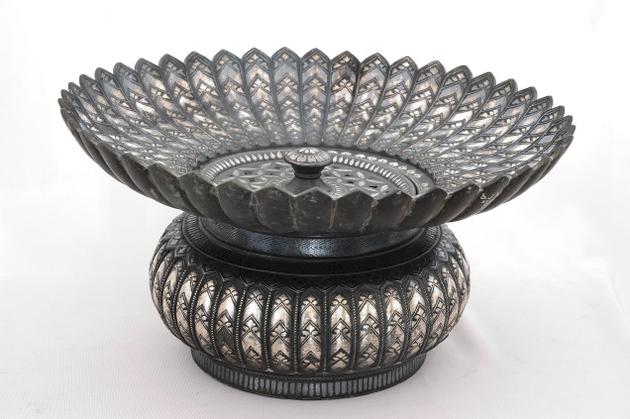 A circular basin with perforated cover inlaid in silver. / Photos: Special Arrangement / The Hindu
A circular basin with perforated cover inlaid in silver. / Photos: Special Arrangement / The Hindu
Their sight is brilliant: silver designs shining against the black metal base. Their variety is extraordinary: spittoons to cloth weights. Wealth of design and varied shapes – the two qualities Bidri wares are praised for – are evidenced in the many specimens of this 400-year-old craft enshrined in Salarjung Museum.
Bidri gets its name from Bidar, some 200 kilometres from Hyderabad.
The basic material of Bidri is an alloy of zinc, copper and lead. There are five stages in the production of Bidri: casting, polishing, engraving, inlaying and blackening.
The decorative methods in Bidri consist of – inlay of wire, inlay of sheet, low relief, high relief, cut-out designs in super imposed metal sheets.
Silver is chiefly used for ornamentation, and gold, very rarely.
The preference for silver is obvious: it creates better contrast when inlaid over the ebony coloured Bidri metal.
Bidri ware, like many other crafts, was a fruit of our contacts with Persia. The art of inlaying precious materials over the articles of daily use is peculiar to Persia and other Middle Eastern countries. The Iranian craftsmen who came to Bidar some 400 years back developed the crafts. It later moved to north India and Hyderabad.
The museum’s Bidri collections of huqqa bottoms, Aftabas, trinket boxes, goglets, spice boxes, contain mostly designs of wine creeper and poppy plants. Geometrical decorations also appear. Later products show Hindu lotus decoration.
A special case is a Bidri huqqa designed with a mixture of Persian and European patterns, the latter having been introduced by the French in 18th century.
B. Kotaiah, Dep. Keeper (Retd) Salarjung Museum
source: http://www.TheHindu.com / Home> News> Cities> Hyderabad / by B. Kotaiah / November 22nd, 2012